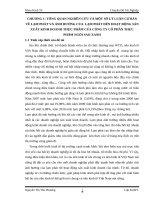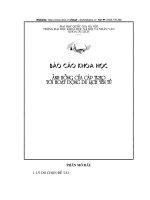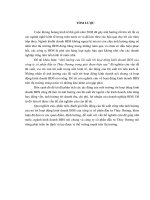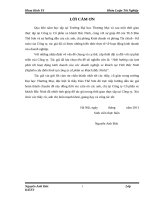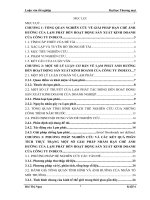Những ảnh hưởng của đạo Khổng tới hoạt động dạy - học ở bậc Đại học tại Việt Nam
Bạn đang xem bản rút gọn của tài liệu. Xem và tải ngay bản đầy đủ của tài liệu tại đây (147.15 KB, 9 trang )
TẠP CHÍ KHOA HỌC ĐẠI HỌC TÂN TRÀO
THE INFLUENCES OF CONFUCIAN IDEOLOGY ON THE RELATIONSHIP BETWEEN
TEACHING AND LEARNING AT HIGHER EDUCATION IN VIETNAM
Những ảnh hưởng của đạo Khổng tới hoạt động dạy - học ở bậc Đại học tại Việt Nam
TS. Nguyễn Cao Thành*
TÓM TẮT
Bài viết nghiên cứu về sự ảnh hưởng của đạo Khổng tới việc dạy-học ở các trường Đại học
Việt Nam. Bản chất của đạo Khổng và sự ảnh hưởng tại Việt Nam nói chung và lĩnh vực giáo dục
nói riêng đã được khái qt. Ngồi ra, bài viết tập trung sâu vào việc phân tích những ảnh hưởng
của đạo Khổng tới hoạt động dạy-học tại các trường Đại học tại Việt Nam đặc biệt là những ảnh
hưởng đã ít nhiều kìm hãm sự sáng tạo và hiệu quả của hoạt động dạy-học. Cuối cùng bài viết phân
tích và nhấn mạnh những gì mà các nhà giáo dục Việt Nam đã làm và nên làm để mềm hóa và giảm
bớt ảnh hưởng của đạo Khổng tới việc dạy-học ở bậc Đại học tại Việt Nam.
Từ khóa: đạo Khổng; hoạt động dạy-học; giao tiếp thầy-trò
ABSTRACT
The study has examined contextual influences (Confucian influences) on the relationship
between adult teaching and learning in Vietnam. A general picture of Confucian philosophy in
Vietnam has been highlighted with regard to the impact of Confucian on regions in general and on
educational field in particular. Importantly, the paper has also focused on level of Confucian
impacts regarding to adult teaching and learning activities, and especially impacts that inhibit
creativeness and competency of teacher and students’ activities. Finally, the paper has emphasized
on what Vietnamese educators and teachers have tried and should do to modify the impact of
Confucian on the relationship between adult teaching and learning.
Keywords: Confucian ideology; teaching and learning; teacher-student communication
1. Introduction∗
Turner
(2005:17)
indicates
that
“Teaching contexts have a significant impact
on teaching performance, and there are a range
of contextual factors which affect teachers’
development and classroom performance”.
Indeed, there are usually a variety of
contextual factors such as cultural, personality
and organizational which have been affecting
teaching and learning activities. What and how
do contextual aspects influence on the
∗
Trường Đại học Tân Trào
relationship between teaching and learning? It
depends on specific situations in different
countries with different cultures and traditions.
In Asian nations such as Vietnam, where the
cultural and traditional aspects still exist, the
heavy impact of contextual factors is quite
apparent.
In Vietnam, Confucian had existed and
dominated for thousands of years. The
Confucian ideology has deeply affected
morals, politics, and education especially.
Phuoc (1975 cited in Ellis, 1995:05) shows
that “the nature of the teaching and learning
SỐ 02 – THÁNG 3 NĂM 2016
55
TẠP CHÍ KHOA HỌC ĐẠI HỌC TÂN TRÀO
styles in Vietnam stems from Confucian
tradition”.
It has been transmitted from
generations to generations in Vietnamese
society and it has impacted on peoples’
thought and actions. Therefore, in classroom,
where the communication and knowledge
transmission are usually taken place between
teachers and students, the characteristics of
Confucian influences have been obviously
exposed.
Confucianism consists of a set of
pragmatic rules for the daily behaviors of
normal people. According to Irwin (1996), this
set was based on five basic relationships and
moral
bonds.
The
five
hierarchical
relationships among people are ruler/subject,
father/son, husband/wife, older brother/
younger brother, and between friends (Chen &
Chung, 1994). These relationships and moral
bonds also are described as follows:
In this paper, I will analyze the
influences of Confucian ideology on the
relationship between adult teaching and
learning in Vietnam. First of all, the overview
of the influences of Confucian on educational
environment in Vietnam will be highlighted.
The second issue is the impact of Confucian
methodology on the relationship between adult
teaching and learning. The next section is the
evaluation of the gap of communication
between teachers and students. Then there is
the answer for the question: What Vietnamese
educators have tried and should do to modify
the influences of Confucian on adult teachinglearning relationship.
(Confucianism)… is a practical code of
conduct to follow in everyday life, a manual
for
managing
human
relationships
harmoniously. One core rule acknowledges
that there are superiors and inferiors and
states that superiors must act with virtues (te)
and inferiors must obey their superiors. One
should be dutiful towards one’s parents and
elders, reciprocal in one’s obligations,
respectful of human dignity, and fair towards
all. Confucianism
inculcates servility,
frugality, abstinence, and diligence. It
recognizes hard word, patriarchal leadership,
entrepreneurial spirit, and familial devotion
(Engholm 1991, cited in Irwin, 1996:27).
2. The overview of the nature of
Confucian and its influences on educational
environment in Vietnam
Contributing to this, Merriam, S. B;
Caffarella, R. S & Baumgartner, L. M.
(2007:21) assumed that “Adult learning,
according to Confucianism, cannot be used as
a tool for achieving specific goals in a specific
situation. For example, the contents of learning
are not related to vocational or skill
acquirement. Instead, adult learning is focused
on spiritual development”.
Confucian was born in China in 551
B.C. According to Chen & Chung (1994: 18),
“his teachings are mainly concerned with
practical ethics of daily life without any
addition of religion elements”. Vietnam was
one of the most strongly influenced countries
by Confucian because of a thousand years of
Chinese domination (111 BC-AD 939).
Although Confucianism declined in the
country under the invasion period of French
and American rule, its basic precepts remained
deeply in the morals and values of people,
especially teachers and students.
56
SỐ 02 – THÁNG 3 NĂM 2016
However, it is undeniable that,
Confucian is a progressive ideology even in
contemporary society, especially in oriental
countries. It can be said that Confucian has
contributed to social construction. Confucian
teaches people behave to each other morally
and humanely. However, in educational field
TẠP CHÍ KHOA HỌC ĐẠI HỌC TÂN TRÀO
which always requires timely reforms to
follow the development of society, Confucian
in some degree inhibits and negatively
influences educational activities.
In Vietnam, education is always put at
the top priority: educated people often have
honor places in the society. This situation is
stemmed from the traditional Confucian
philosophy that “a man without education is
not a worthy man”. So there are several
famous saying that are learnt by heard by
most of Vietnamese from their childhood to
gratitude their teachers and parents such as:
“Cha me sinh con thầy cho cuộc sống”
My parents give me birth but my
teacher made a man of me
(Tran, 198:20, cited in Tran, Ngyen &
Le, 1988)
recognition and are considered as fathers or
mothers of the learners both morally and
academically.
3. The influences of Confucian on the
relationship between adult teaching and
learning
Kramsch & Sullivan (1996:11) imply the
role of teachers that “with Confucian moral
lesson, teachers in the classroom have played a
role like the father in the family with students
as their children. The teacher is responsible for
students’ improvement not only in the subject
matter but also in moral values”. Because of
these influences, teacher must be responsible
for
students’
achievement
and
the
effectiveness of students is considered as the
result of the excellence of the teacher.
(Learn morals first, learn literacy
With the traditional styles, teachers are
considered as the passers of knowledge and
students as the receivers. Teachers generally
control their students through both legitimated
authority and moral norms. In other words,
students have to follow their teachers’
instruction without any criticism. According to
McLaren (1998:02), in the large power
society, “teachers are considered wise,
authority figures whose word has great
weight”. Hence, the educational process is
teacher-centered; in the classroom there is
supposed to be a strict order with the teacher
initiating communication; students in class
speak up only when invited to (Hofsted, 1991).
It can be seen that Vietnamese
education in general and the relationship
between teaching and learning in particular
have been deeply affected by Confucian
philosophy. Teaching is seen as one of the
most honorable careers in life. Since such
high value is set on education so the
educators, and teachers are given special
The teacher in Vietnam is regarded as
the fountain of knowledge or the transmitter of
knowledge and is dominant in all classroom
activities management. The teachers are
supposed to know everything. In the class,
they act as the “master” who lectures to
deliver the knowledge to the “followers”. The
teachers are expected to feed their student
everything in the class. This is supported by
In other words, the teachers’ position
is always right at the heard of every learner.
At school, there are usually several slogans
which are stuck on the class wall to praise
the teacher’s credit in graduating, that most
of Vietnamese people know since they were
small kids for instance:
“Nhất tự vi sư, bán tự vi sư”
(Whoever teaches me a letter, he
should be my teacher)
Or
“Tiên học lễ, hậu học văn”
later)
SỐ 02 – THÁNG 3 NĂM 2016
57
TẠP CHÍ KHOA HỌC ĐẠI HỌC TÂN TRÀO
Nguyen (1994:12) that “the major methods
used by the majority of the teacher are rote
learning and one way transmission of
knowledge”. Additionally, in a research about
the reality of the teaching situation in Vietnam,
Nguyen, (1999:34) had an idea from Dinh
Quang Bao – Head Master of Teacher training
University that “lecturing is still the major
method, neglecting the active and creative
characteristics of the learners”.
Moreover, the teaching style in Vietnam
is much authoritarian. The teacher is usually a
bright example and is always right. Normally,
at tertiary level, students should be given more
independent work because after universities,
graduated students will be experts in every
region. Additionally, at universities, students
often have to work by themselves instead of
entire depending on teachers. However, in
Vietnam, the situation is much more different.
Vu (1995:08) reports that “In Vietnam, the
teacher gives lectures in the forms of reading,
speaking about the content of the lesson and
writing on the board what is required to be
remembered. The student listen to the
teacher’s talk and take notes in silent”. As a
result, the student is the victim of the “spoonfed” teaching approach. They are really
passive and dependent to the teacher.
The teaching and learning styles in
Vietnam are really collectivist. Students feel at
ease to follow the class activities but not
working independently. This is rooted from
traditional teaching and learning styles. Nelson
(1995:8-9) gives an idea about the Confucian
educational system as “Within the Confucian
system, students learn through cooperation, by
working for the common good, by supporting
each other and by not elevating each
themselves above others”. The teachers
usually focus their teaching to the whole class,
58
SỐ 02 – THÁNG 3 NĂM 2016
but not at the individual. This extremely
contrasts with the Western approaches in
teaching and learning. Print (1993:04)
demonstrates one kind of teaching method at
universities in Australia “a classroom teacher
may wish to develop empathic attitudes in
students by involving learners in a role-playing
exercise based on people with physical
deformities”. Therefore, in fact, Vietnamese
students are often not competent at soft skills
such as group discussion, workshop or
presentation which often require students’
constructive opinions.
4. The impact of Confucian regarding
to the communication between teachers and
students
The communication between teachers
and students at universities often play a very
important
role
in
enhancement
the
effectiveness and efficiency in both teaching
and learning. Beside the received knowledge
in class, students usually need the
consultancies and suggestions from the
teachers. Furthermore, the close relationship
between teachers and students will create a
mutual understanding environment and it may
lead to an effective and efficient outcome in
both teaching and learning. Moreover, through
the communication, there could have
sympathy from the teacher toward students
who come from different socio-economic
backgrounds. Hence, it can be argued that, the
limitation in teacher-student communication in
Vietnam is one of the negative consequences
from Confucian influences.
According to Confucian ideology,
“argument and question with the elder and the
teacher are rude and unacceptable” (Cuu,
2001:11). Because of that, there is rarely any
communication between teachers and learners.
The learners often feel that their teachers are
TẠP CHÍ KHOA HỌC ĐẠI HỌC TÂN TRÀO
so much superior that leads to the situation of
feeling fear when working or interacting with
the teachers. Consequently, the learners do not
dare sharing their opinions. Moreover, the
teachers are not able to have a close and
friendly relationship with their students
because of the tradition that they would lose
the power control and great respect over their
students. So there exists a long distance
between the teachers and the students.
Another factor that makes Vietnamese
teacher and learner’s communication more
difficult is the notion of “keeping face”. Wei
(1977:21) said that “the Vietnamese
traditionally do not reveal any of their
problems to outsiders because such of the
revelation is view as sign of the weakness.
Problems are solved within the family, and
exposure of them to non-family member is
considered shameful not only for the
individual but also for the family and even for
the entire nation”. Contributing to the
perception of face, Sullivan (1994:87) notices
that “Asian cultures like to pay more attention
to face in the form of saving face or losing
face”. In the class, neither the teachers nor the
students should be made to lose face. On one
hand, the students keep quiet in the class
without discussing and contributing to the
teacher’s lecture to show their respect toward
their teacher and to avoid making mistakes and
losing face in public. As Hwang (1986: 248)
points out “he or she must pay attention to
preserving other’s face in social encounters,
especially the face of the superiors”. On the
other hand, the teachers rarely give students
chances to question and maximum avoidance
of answering the learners’ question by “I do
not know”. (They are at all times supposed to
know everything). As a result, the
communicating transactions between the two
partners are so weak and the students are not
really connected to the class and the lessons.
Moreover, Confucian always guides the
younger have to absolutely obey and listen to
the elder and teachers (Ban, 2000). When
talking or addressing the teacher, Vietnamese
learners always say “thua thay”, “thua co” to
show their great respect. “Thua” is is a very
polite form which is used before a personal
pronoun to talk to someone superior in both
family and social rank. In return, the teachers
often address their students by using “con”
(child), “em” (younger sibling), or “anh/chi”
(elderly brother/sister). The terms “con” and
“em” are used in most of the educational level.
Hence, the carefulness of students with
teachers in communication might make the
conversation become less natural and strained.
5. How and what Vietnamese
educators have tried and should do to
modify the Confucian influences in an effort
to enhance teaching-learning outcome
5.1 How have Vietnamese educator
tried to lessen the impact of Confucian?
In recent years, the Ministry of
Education and Training in Vietnam has
realized the negative sides of Confucian and
one of the typical negative consequences is
teacher-centered teaching methods. Therefore,
the traditional Vietnamese learning and
teaching styles are changing step by step
towards student-centered approach. The
statistics of Vietnamese Education and
Training Ministry indicated that “from 1990 to
2000, there had more than 1000 tertiary
lecturers who have been retrained with new
teaching
approaches”
(Vietnamese
Educational Journal, 2005:3). Noticeably,
many lectures have been conducted by foreign
instructors who come from the progressive
educations in the world. It can be asserted that
SỐ 02 – THÁNG 3 NĂM 2016
59
TẠP CHÍ KHOA HỌC ĐẠI HỌC TÂN TRÀO
this reform is extremely beneficial for adult
teaching and learning.
One of the most important factors in
educational reform is the educational
cooperation between Vietnam and other
countries. In recent years, there have been a
considerable numbers of teachers who were
sent to other countries for training. They were
selected from lecturers of Teacher Training
College or Universities. A typical example is
that, at La Trobe University, Australia, from
2000 to 2007 there were more than 100
Vietnamese students, who were lecturers at
educational universities in Vietnam, were
studying. With the receiving of new teaching
methods as well as the progressive ways of
learning, those teachers have contributed to
reducing the Confucian-traditional influences
on teaching and learning, and applying new
teaching methods to student-center approach.
5.2. What should Vietnamese educators
and teachers do?
It is difficult to put forward the most
effective and efficient solution to reduce the
contextual
influences,
especially
in
Vietnamese situation, where the educational
reform is on the way. However, based on the
acknowledgeable and reliable evaluation from
educational researchers, Vietnamese educators
and teachers may flexibly apply in specific
situations. Particularly, the prior work of
Vietnamese educators is to reduce the
Confucian influences on the relationship
between teaching and learning as much as
possible. The following implications of
educational researchers (Zais, 1976; Pratt,
1980; Joyce & Weil, 1992; Brady, 1992;
Saylor, Alexander & Lewis, 1981. cited in
Print, 1993) are worth to notice:
1. Not all students learn equally well
when the same strategies are employed (…)
60
SỐ 02 – THÁNG 3 NĂM 2016
2. Certain teaching-learning methods are
more applicable to particular situations.
Lecturers, for example, are not as appropriate
when one is trying to develop student selfconcepts as small group work or
individualized tasks. No one strategy is
appropriate, or can hope to be appropriate, to
all learning contexts.
3. No single method is superior,
particularly in terms of student performance,
to another in all learning situation. One may be
more efficient in one situation and less
effective in another. (…)
The findings mention the important role
of teachers in using strategies in their teaching
and addressing to students’ needs. At
universities in Vietnam, students usually come
from different geographic areas and socioeconomical contexts. Hence, students coming
from cities are often less influenced by
Confucian and tradition. Conversely, rural
students usually still keep traditional
characteristics along in their learning style
(Phu, 2001). Because of that, coping with
different and diverse learning’s needs is one of
the key tasks of Vietnamese teachers at tertiary
level. Darling & Bransford (2005:23) shows
the key functions of teachers that:
Teachers need to know that general
theories of learning, although they provide
guidelines for the design of effective learning
environments, cannot produce a single recipe
to use in all situations. One of the key features
of modern leaning theory is that optimal
leaning environment must be tailored to
specific leaning goals, to the students’
backgrounds and prior knowledge, and to the
contexts in which learning will occur. Thus
teachers not only need to understand basic
principles of learning but must also know how
to use them judiciously to meet diverse
TẠP CHÍ KHOA HỌC ĐẠI HỌC TÂN TRÀO
learning goals in contexts where student differ
in theirs needs (…). Teachers need to learn
how to evaluate the salience of many different
conditions that influence learning and the
potential effectiveness of different teaching
strategies as they make decisions about what to
do in particular instances. To do this, teachers
need to develop a conceptual map of the
domain of influences on learning (including
both contextual influences and the impacts of
different teaching strategies), and they need to
develop means for evaluating how these may
be operating in specific instance.
The above evaluation implicates that one
of the principle tasks of teachers is how to
flexibly adapt with different learning needs. In
addition, teachers should know what are
learners’ lacks and wants. These are very
necessary to adult teaching and learning in
Vietnam, especially in the effort to shift from
teacher-centered approach to learner-centered
approach.
One of the important factors which
should not be ignored during the transfer from
teacher-centered to student-centered is to
comprehensively understand and appreciate
students. The following typical demonstration,
which was conducted by Onsman, (1991: 51 &
52), can explain more about this.
• Adults learn by doing.
• Adults lean when they have a need
to learn.
• Adults learn by solving problems.
• Different adults learn in different ways.
• Adults
activities.
like
variety
in
learning
• Adults want feedback on performance
• Adults want to apply what they learn.
• Adults learn when the learning fits into
their value systems.
• Adults already know lots of things.
It could be explained that there are
particular characteristics in adult learning. The
purpose of adult learning differs from children
learning, not only receiving general
knowledge, adults also need the knowledge
which they lack and they want. Furthermore,
adult learn to seek a job after finishing
universities. To address this issue properly and
effectively, lecturers should give learners more
opportunities to exposure themselves (this is
one of the inherent weakness of adult teaching
in Vietnam).
Regarding to approach the student-center
in adult teaching, the lecturers in Vietnam
should apply new teaching methods which are
more suitable with students’ needs. According
to Print (1993:172), teachers should use the
method of inquiryteaching/problem solving
“Instead of teachers providing information for
learners to digest, students are first posed a
problem, a question to solve, a dilemma to
resolve or an issue to address, which they learn
about through the process of finding an
answer”. Print(1993:176) also shows another
teaching approach which is the models of
reality “An alternative way to facilitate
effective learning within students is to involve
them in learning situations that are as real life
as possible”. Obviously, in these approaches,
teachers only act as guiders and students have
to solve the issues by themselves under the
guiding of teachers.
However, on the way to implementing
the student-centered approach, lecturers should
not ignore the previous knowledge and the
knowledge which learners already know. As a
result, Constructivism, which is a progressive
theory, indicates the ways to consolidate that
issue in the attempt to implement studentcentered approach. Following constructivist
SỐ 02 – THÁNG 3 NĂM 2016
61
TẠP CHÍ KHOA HỌC ĐẠI HỌC TÂN TRÀO
theories, Fry, Ketteridge & Marshal (1999:10)
express that “Some of the ways in which this
was done were to encourage learners to
understand how the past is reconstructed and
understood (…) Lecturers should be
considering how to bring about change or
transformation to the pre-existing knowledge
of their learner”. Thus, the lecturers’ job is not
only transmitting new knowledge and new
methods, but also to evoke the knowledge
which was already existed in students’ fund of
understanding.
6. Conclusion
To sum up, the paper has examined
contextual influences (Confucian influences)
on the relationship between adult teaching and
learning in Vietnam. A general picture of
Confucian philosophy in Vietnam has been
highlighted with regard to the impact of
Confucian in regions in general and in
educational field in particular. Moreover, the
paper has also focused on level of Confucian
impacts regarding to adult teaching and
learning activities, and some typical negative
consequences of Confucian ideology to
teachers and students. Another influence of
Confucian on teacher-learner communication
has been evaluated, especially the distance of
teacher-student relationship in classroom and
outside as well. Importantly, the paper has
emphasized on what Vietnamese educators
and teachers have tried and should do to
modify the impact of Confucian on the
relationship between adult teaching and
learning.
The above arguments have indicated that
the relationship between adult teaching and
learning is quite deeply affected by contextual
influence. It obviously intervenes in teaching
and learning activities, and influences the
educational outcome. In Vietnam, the
Confucian has existed for ages, so its
influences on morals, political and especially
in education is unavoidable. In attempts to get
it off the ground, Vietnamese government and
educational administrators have been trying to
reduce the unsuitable impact of Confucian on
education in general and in the adult teachinglearning relationship in particular.
REFERENCES
1. Ban, K. T.(2000) The impacts of Confucian on learning environment. Hanoi Education
University Publisher.
2. Bruner, J.(1996) The culture of education. Harvard University Press, Cambridge Mass.
3. Cuu, N. L. (2001). Communication in classroom. Vietnamese Educational Newspaper.
4. Chen, G.M & Chung, J. (1994). The impact of Confucianism on organizational
communication. Communication Quarterly. University Part. 42 (2), pp 93-112.
5. Driscoll, M.P. (1994). Psychology of Learning for Instruction. Needham Heights: Allyn & Bacon.
6. Ellis, G., 1995. Teaching and learning styles in Vietnam: Lessons for Australian educators.
Journal of Vietnamese studies, 8, pp 9-16.
7. Darling, L. H. & Bransford, J.(2005) Preparing Teachers for a Changing World: What
Teachers Should Learn and Be Able to Do. Jossey-Bass.
62
SỐ 02 – THÁNG 3 NĂM 2016
TẠP CHÍ KHOA HỌC ĐẠI HỌC TÂN TRÀO
8. Fry, H., Ketteridge, S. & Marshall. (1999) Understanding student learning. Development
of practice.
9. Hwang, K. K. (1986). The psychology of the Chinese people. HK: Oxford University Press.
10. McLaren, M. (1998). Interpreting culture differences. Peter Francis publisher. UK
11. Merriam, S.B.; Caffarella, R.S. & Baumgartner, L.M. (2007) Learning in Adulthood. John
Wiley & Sons, Inc.
12. Hofstede,
G.
(1991).
Cultures
and
Organizations:
Software
of
the
mind.
HarperCollinsPublishers. London.
13. Irwin, H. (1996). Communicating with Asia: Understanding People and Customs. Allen
& Unwin. NSW, Australia.
14. Kramsch, C. & Sullivan, P. (1996). Appropriate pedagogy. ELT journal, (50), 199-212
15. Nelson (1995). Cultural differences in learning styles. In Reid, J (Ed.), Learning styles in
the ESL/EFL classroom. Boston: Heinle & Heinle.
16. Nguyen, X. T. (1994). Education in Vietnam: an overview. In Nguyen Xuan Thu (Ed.).
17. Nguyen, K. D. (1999). The teacher training quality. The People. Vietnam: The People
newspaper.
18. Onsman. (1991: 51&52) Asignment of Instructional Strategies to Adult Learning
Principle.
19. Print, M. (1993) Curriculum Development and Design. Sydney: Allen and Unwin.
20. Phu, N. M.(2001) A sympathy towards students. Hanoi National University Publisher
21. Sullivan, K. (1994). Understanding ways. London: Hale & Ironmoger.
22. Turner, R. B.(2005) Expert Teaching: Knowledge and Pedagogy to Lead the Profession.
London. David Fulton Publisher.
23. Tran, T. N. M. & Nguyen, T. T. H. & Le, L. L. (1988). Vietnamese Language & Cultures.
Australia: Vietnamese Community in Australia.
24. Vu, V. T. (1995). Some cultural features of Vietnamese life and teacher education. In
Barthel & Ho, V. (Eds.) & Alex & Dinh, Q. T.(trans). Intercultural interaction and development:
converging perspectives conferences proceedings. Sydney: University of technology.
25. Wei, T. (1977). Vietnamese refugee students: A handbook for personnel. Cambridge:
National Assessment & Dissemination center.
SỐ 02 – THÁNG 3 NĂM 2016
63



